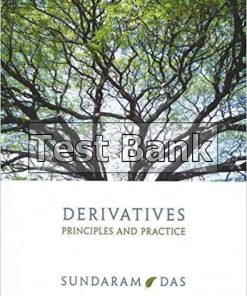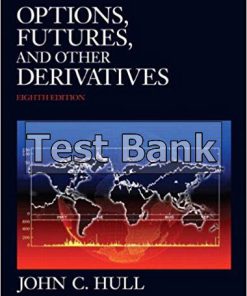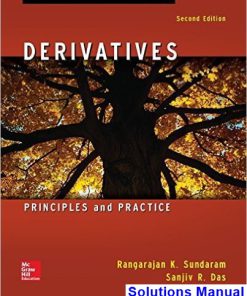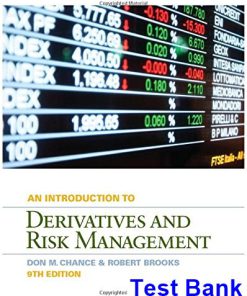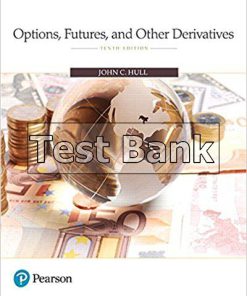Derivatives 2nd Edition Sundaram Test Bank
$50.00 Original price was: $50.00.$26.50Current price is: $26.50.
Derivatives 2nd Edition Sundaram Test Bank.
This is completed downloadable of Derivatives 2nd Edition Sundaram Test Bank
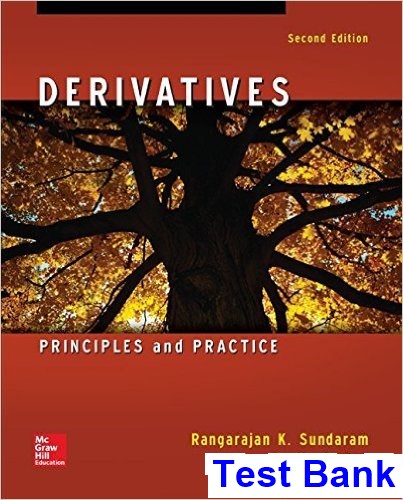
Product Details:
- ISBN-10 : 0078034736
- ISBN-13 : 978-0078034732
- Author: Rangarajan Sundaram (Author), Sanjiv Das (Author)
Derivatives makes a special effort throughout the text to explain what lies behind the formal mathematics of pricing and hedging. Questions ranging from ‘how are forward prices determined?’ to ‘why does the Black-Scholes formula have the form it does?’ are answered throughout the text. The authors use verbal and pictorial expositions, and sometimes simple mathematical models, to explain underlying principles before proceeding to formal analysis. Extensive uses of numerical examples for illustrative purposes are used throughout to supplement the intuitive and formal presentations.
Table of Content:
- Chapter 1: Introduction
- 1.1 Forward and Futures Contracts
- 1.2 Options
- 1.3 Swaps
- 1.4 Using Derivatives: Some Comments
- 1.5 The Structure of this Book
- 1.6 Exercises
- Part One: Futures and Forwards
- Chapter 2: Futures Markets
- 2.1 Introduction
- 2.2 The Functioning of Futures Exchanges
- 2.3 The Standardization of Futures Contracts
- 2.4 Closing Out Positions
- 2.5 Margin Requirements and Default Risk
- 2.6 Case Studies in Futures Markets
- 2.7 Exercises
- Appendix 2A: Futures Trading and US Regulation: A Brief History
- Appendix 2B: Contango, Backwardation, and Rollover Cash Flows
- Chapter 3: Pricing Forwards and Futures I: The Basic Theory
- 3.1 Introduction
- 3.2 Pricing Forwards by Replication
- 3.3 Examples
- 3.4 Forward Pricing on Currencies and Related Assets
- 3.5 Forward-Rate Agreements
- 3.6 Concept Check
- 3.7 The Marked-to-Market Value of a Forward Contract
- 3.8 Futures Prices
- 3.9 Exercises
- Appendix 3A: Compounding Frequency
- Appendix 3B: Forward and Futures Prices with Constant Interest Rates
- Appendix 3C: Rolling Over Futures Contracts
- Chapter 4: Pricing Forwards and Futures II: Building on the Foundations
- 4.1 Introduction
- 4.2 From Theory to Reality
- 4.3 The Implied Repo Rate
- 4.4 Transactions Costs
- 4.5 Forward Prices and Future Spot Prices
- 4.6 Index Arbitrage
- 4.7 Exercises
- Appendix 4A: Forward Prices with Convenience Yields
- Chapter 5: Hedging with Futures and Forwards
- 5.1 Introduction
- 5.2 A Guide to the Main Results
- 5.3 The Cash Flow from a Hedged Position
- 5.4 The Case of No Basis Risk
- 5.5 The Minimum-Variance Hedge Ratio
- 5.6 Examples
- 5.7 Implementation
- 5.8 Further Issues in Implementation
- 5.9 Index Futures and Changing Equity Risk
- 5.10 Fixed-Income Futures and Duration-Based Hedging
- 5.11 Exercises
- Appendix 5A: Derivation of the Optimal TailedHedge Ratio h **
- Chapter 6: Interest-Rate Forwards and Futures
- 6.1 Introduction
- 6.2 Eurodollars and Libor Rates
- 6.3 Forward-Rate Agreements
- 6.4 Eurodollar Futures
- 6.5 Treasury Bond Futures
- 6.6 Treasury Note Futures
- 6.7 Treasury Bill Futures
- 6.8 Duration-Based Hedging
- 6.9 Exercises
- Appendix 6A: PVBP-Based Hedging Using Eurodollar Futures
- Appendix 6B: Calculating the Conversion Factor
- Appendix 6C: Duration as a Sensitivity Measure
- Appendix 6D: The Duration of a Futures Contract
- Part Two: Options
- Chapter 7: Options Markets
- 7.1 Introduction
- 7.2 Definitions and Terminology
- 7.3 Options as Financial Insurance
- 7.4 Naked Option Positions
- 7.5 Options as Views on Market Direction and Volatility
- 7.6 Exercises
- Appendix 7A: Options Markets
- Chapter 8: Options: Payoffs and Trading Strategies
- 8.1 Introduction
- 8.2 Trading Strategies I: Covered Calls and Protective Puts
- 8.3 Trading Strategies II: Spreads
- 8.4 Trading Strategies III: Combinations
- 8.5 Trading Strategies IV: Other Strategies
- 8.6 Which Strategies Are the Most Widely Used?
- 8.7 The Barings Case
- 8.8 Exercises
- Appendix 8A: Asymmetric Butterfly Spreads
- Chapter 9: No-Arbitrage Restrictions on Option Prices
- 9.1 Introduction
- 9.2 Motivating Examples
- 9.3 Notation and Other Preliminaries
- 9.4 Maximum and Minimum Prices for Options
- 9.5 The Insurance Value of an Option
- 9.6 Option Prices and Contract Parameters
- 9.7 Numerical Examples
- 9.8 Exercises
- Chapter 10: Early Exercise and Put-Call Parity
- 10.1 Introduction
- 10.2 A Decomposition of Option Prices
- 10.3 The Optimality of Early Exercise
- 10.4 Put-Call Parity
- 10.5 Exercises
- Chapter 11: Option Pricing: A First Pass
- 11.1 Overview
- 11.2 The Binomial Model
- 11.3 Pricing by Replication in a One-Period Binomial Model
- 11.4 Comments
- 11.5 Riskless Hedge Portfolios
- 11.6 Pricing Using Risk-Neutral Probabilities
- 11.7 The One-Period Model in General Notation
- 11.8 The Delta of an Option
- 11.9 An Application: Portfolio Insurance
- 11.10 Exercises
- Appendix 11A: Riskless Hedge Portfolios and Option Pricing
- Appendix 11B: Risk-Neutral Probabilities and Arrow Security Prices
- Appendix 11C: The Risk-Neutral Probability, No-Arbitrage, and Market Completeness
- Appendix 11D: Equivalent Martingale Measures
- Chapter 12: Binomial Option Pricing
- 12.1 Introduction
- 12.2 The Two-Period Binomial Tree
- 12.3 Pricing Two-Period European Options
- 12.4 European Option Pricing in General n-Period Trees
- 12.5 Pricing American Options: Preliminary Comments
- 12.6 American Puts on Non-Dividend-Paying Stocks
- 12.7 Cash Dividends in the Binomial Tree
- 12.8 An Alternative Approach to Cash Dividends
- 12.9 Dividend Yields in Binomial Trees
- 12.10 Exercises
- Appendix 12A: A General Representation of European Option Prices
- Chapter 13: Implementing Binomial Models
- 13.1 Introduction
- 13.2 The Lognormal Distribution
- 13.3 Binomial Approximations of the Lognormal
- 13.4 Computer Implementation of the Binomial Model
- 13.5 Exercises
- Appendix 13A: Estimating Historical Volatility
- Chapter 14: The Black-Scholes Model
- 14.1 Introduction
- 14.2 Option Pricing in the Black-Scholes Setting
- 14.3 Remarks on the Formula
- 14.4 Working with the Formulae I: Plotting Option Prices
- 14.5 Working with the Formulae II: Algebraic Manipulation
- 14.6 Dividends in the Black-Scholes Model
- 14.7 Options on Indices, Currencies, and Futures
- 14.8 Testing the Black-Scholes Model: Implied Volatility
- 14.9 The VIX and Its Derivatives
- 14.10 Exercises
- Appendix 14A: Further Properties of the Black-Scholes Delta
- Appendix 14B: Variance and Volatility Swaps
- Chapter 15: The Mathematics of Black-Scholes
- 15.1 Introduction
- 15.2 Geometric Brownian Motion Defined
- 15.3 The Black-Scholes Formula via Replication
- 15.4 The Black-Scholes Formula via Risk-Neutral Pricing
- 15.5 The Black-Scholes Formula via CAPM
- 15.6 Exercises
- Chapter 16: Options Modeling: Beyond Black-Scholes
- 16.1 Introduction
- 16.2 Jump-Diffusion Models
- 16.3 Stochastic Volatility
- 16.4 GARCH Models
- 16.5 Other Approaches
- 16.6 Implied Binomial Trees/Local Volatility Models
- 16.7 Summary
- 16.8 Exercises
- Appendix 16A: Program Code for Jump- Diffusions
- Appendix 16B: Program Code for a Stochastic Volatility Model
- Appendix 16C: Heuristic Comments on Option Pricing under Stochastic Volatility See online at www.mhh
- Appendix 16D: Program Code for SimulatingGARCH Stock Prices Distributions
- Appendix 16E: Local Volatility Models: The FourthPeriod of the ExampleSee online at www.mhhe.com/sd2
- Chapter 17: Sensitivity Analysis: The Option “Greeks”
- 17.1 Introduction
- 17.2 Interpreting the Greeks: A Snapshot View
- 17.3 The Option Delta
- 17.4 The Option Gamma
- 17.5 The Option Theta
- 17.6 The Option Vega
- 17.7 The Option Rho
- 17.8 Portfolio Greeks
- 17.9 Exercises
- Appendix 17A: Deriving the Black-Scholes Option Greeks
- Chapter 18: Exotic Options I: Path-Independent Options
- 18.1 Introduction
- 18.2 Forward Start Options
- 18.3 Binary/Digital Options
- 18.4 Chooser Options
- 18.5 Compound Options
- 18.6 Exchange Options
- 18.7 Quanto Options
- 18.8 Variants on the Exchange Option Theme
- 18.9 Exercises
- Chapter 19: Exotic Options II: Path-Dependent Options
- 19.1 Path-Dependent Exotic Options
- 19.2 Barrier Options
- 19.3 Asian Options
- 19.4 Lookback Options
- 19.5 Cliquets
- 19.6 Shout Options
- 19.7 Exercises
- Appendix 19A: Barrier Option Pricing Formulae
- Chapter 20: Value-at-Risk
- 20.1 Introduction
- 20.2 Value-at-Risk
- 20.3 Risk Decomposition
- 20.4 Coherent Risk Measures
- 20.5 Exercises
- Chapter 21: Convertible Bonds
- 21.1 Introduction
- 21.2 Convertible Bond Terminology
- 21.3 Main Features of Convertible Bonds
- 21.4 Breakeven Analysis
- 21.5 Pricing Convertibles: A First Pass
- 21.6 Incorporating Credit Risk
- 21.7 Convertible Greeks
- 21.8 Convertible Arbitrage
- 21.9 Summary
- 21.10 Exercises
- Appendix 21A: Octave Code for the Blended Discount Rate Valuation Tree
- Appendix 21B: Octave Code for the Simplified Das-Sundaram Model
- Chapter 22: Real Options
- 22.1 Introduction
- 22.2 Preliminary Analysis and Examples
- 22.3 A Real Options “Case Study”
- 22.4 Creating the State Space
- 22.5 Applications of Real Options
- 22.6 Summary
- 22.7 Exercises
- Part Three: Swaps
- Chapter 23: Interest Rate Swaps and Floating-Rate Products
- 23.1 Introduction
- 23.2 Floating-Rate Notes
- 23.3 Interest Rate Swaps
- 23.4 Uses of Swaps
- 23.5 Swap Payoffs
- 23.6 Valuing and Pricing Swaps
- 23.7 Extending the Pricing Arguments
- 23.8 Case Study: The Procter & Gamble–Bankers Trust “5/30” Swap
- 23.9 Case Study: A Long-Term Capital Management “Convergence Trade”
- 23.10 Credit Risk and Credit Exposure
- 23.11 Hedging Swaps
- 23.12 Caps, Floors, and Swaptions
- 23.13 The Black Model for Pricing Caps, Floors, and Swaptions
- 23.14 Summary
- 23.15 Exercises
- Chapter 24: Equity Swaps
- 24.1 Introduction
- 24.2 Uses of Equity Swaps
- 24.3 Payoffs from Equity Swaps
- 24.4 Valuation and Pricing of Equity Swaps
- 24.5 Summary
- 24.6 Exercises
- Chapter 25: Currency and Commodity Swaps
- 25.1 Introduction
- 25.2 Currency Swaps
- 25.3 Commodity Swaps
- 25.4 Summary
- 25.5 Exercises
- Part Four: Interest Rate Modeling
- Chapter 26: The Term Structure of Interest Rates: Concepts
- 26.1 Introduction
- 26.2 The Yield-to-Maturity
- 26.3 The Term Structure of Interest Rates
- 26.4 Discount Functions
- 26.5 Zero-Coupon Rates
- 26.6 Forward Rates
- 26.7 Yield-to-Maturity, Zero-Coupon Rates, and Forward Rates
- 26.8 Constructing the Yield-to-Maturity Curve: An Empirical Illustration
- 26.9 Summary
- 26.10 Exercises
- Appendix 26A: The Raw YTM Data
- Chapter 27: Estimating the Yield Curve
- 27.1 Introduction
- 27.2 Bootstrapping
- 27.3 Splines
- 27.4 Polynomial Splines
- 27.5 Exponential Splines
- 27.6 Implementation Issues with Splines
- 27.7 The Nelson-Siegel-Svensson Approach
- 27.8 Summary
- 27.9 Exercises
- Appendix 27A: Bootstrapping by Matrix Inversion
- Appendix 27B: Implementation with Exponential Splines
- Chapter 28: Modeling Term-Structure Movements
- 28.1 Introduction
- 28.2 Interest-Rate Modeling versus Equity Modeling
- 28.3 Arbitrage Violations: A Simple Example
- 28.4 “No-Arbitrage” and “Equilibrium” Models
- 28.5 Summary
- 28.6 Exercises
- Chapter 29: Factor Models of the Term Structure
- 29.1 Overview
- 29.2 The Black-Derman-Toy Model See online at www.mhhe.com/sd2e
- 29.3 The Ho-Lee Model See online at www.mhhe.com/sd2e
- 29.4 One-Factor Models
- 29.5 Multifactor Models
- 29.6 Affine Factor Models
- 29.7 Summary
- 29.8 Exercises
- Appendix 29A: Deriving the Fundamental PDE in Factor Models
- Chapter 30: The Heath-Jarrow-Morton and Libor Market Models
- 30.1 Overview
- 30.2 The HJM Framework: Preliminary Comments
- 30.3 A One-Factor HJM Model
- 30.4 A Two-Factor HJM Setting
- 30.5 The HJM Risk-Neutral Drifts: An Algebraic Derivation
- 30.6 Libor Market Models
- 30.7 Mathematical Excursion: Martingales
- 30.8 Libor Rates: Notation
- 30.9 Risk-Neutral Pricing in the LMM
- 30.10 Simulation of the Market Model
- 30.11 Calibration
- 30.12 Swap Market Models
- 30.13 Swaptions
- 30.14 Summary
- 30.15 Exercises
- Appendix 30A: Risk-Neutral Drifts and Volatilities in HJM
- Part Five: Credit Risk
- Chapter 31: Credit Derivative Products
- 31.1 Introduction
- 31.2 Total Return Swaps
- 31.3 Credit Spread Options/Forwards
- 31.4 Credit Default Swaps
- 31.5 Credit-Linked Notes
- 31.6 Correlation Products
- 31.7 Summary
- 31.8 Exercises
- Appendix 31A: The CDS Big Bang
- Chapter 32: Structural Models of Default Risk
- 32.1 Introduction
- 32.2 The Merton (1974) Model
- 32.3 Issues in Implementation
- 32.4 A Practitioner Model
- 32.5 Extensions of the Merton Model
- 32.6 Evaluation of the Structural Model Approach
- 32.7 Summary
- 32.8 Exercises
- Appendix 32A The Delianedis-Geske Model
- Chapter 33: Reduced-Form Models of Default Risk
- 33.1 Introduction
- 33.2 Modeling Default I: Intensity Processes
- 33.3 Modeling Default II: Recovery Rate Conventions
- 33.4 The Litterman-Iben Model
- 33.5 The Duffie-Singleton Result
- 33.6 Defaultable HJM Models
- 33.7 Ratings-Based Modeling: The JLT Model
- 33.8 An Application of Reduced-Form Models: Pricing CDS
- 33.9 Summary
- 33.10 Exercises
- Appendix 33A Duffie-Singleton in Discrete Time
- Appendix 33B Derivation of the Drift-Volatility Relationship
- Chapter 34: Modeling Correlated Default
- 34.1 Introduction
- 34.2 Examples of Correlated Default Products
- 34.3 Simple Correlated Default Math
- 34.4 Structural Models Based on Asset Values
- 34.5 Reduced-Form Models
- 34.6 Multiperiod Correlated Default
- 34.7 Fast Computation of Credit Portfolio Loss Distributions without Simulation
- 34.8 Copula Functions
- 34.9 Top-Down Modeling of Credit Portfolio Loss
- 34.10 Summary
- 34.11 Exercises
- Part Six: Computation
- Chapter 35: Derivative Pricing with Finite Differencing
- 35.1 Introduction
- 35.2 Solving Differential Equations
- 35.3 A First Approach to Pricing Equity Options
- 35.4 Implicit Finite Differencing
- 35.5 The Crank-Nicholson Scheme
- 35.6 Finite Differencing for Term-Structure Models
- 35.7 Summary
- 35.8 Exercises
- Chapter 36: Derivative Pricing with Monte Carlo Simulation
- 36.1 Introduction
- 36.2 Simulating Normal Random Variables
- 36.3 Bivariate Random Variables
- 36.4 Cholesky Decomposition
- 36.5 Stochastic Processes for Equity Prices
- 36.6 ARCH Models
- 36.7 Interest-Rate Processes
- 36.8 Estimating Historical Volatility for Equities
- 36.9 Estimating Historical Volatility for Interest Rates
- 36.10 Path-Dependent Options
- 36.11 Variance Reduction
- 36.12 Monte Carlo for American Options
- 36.13 Summary
- 36.14 Exercises
- Chapter 37: Using Octave
- 37.1 Some Simple Commands
- 37.2 Regression and Integration
- 37.3 Reading in Data, Sorting, and Finding
- 37.4 Equation Solving
- 37.5 Screenshots
- Bibliography
- Name Index
- A
- B
- C
- D
- E
- F
- G
- H
- I
- J
- K
- L
- M
- N
- O
- P
- R
- S
- T
- V
- W
- X
- Y
- Z
- Subject Index
- A
- B
- C
- D
- E
- F
- G
- H
- I
- J
- K
- L
- M
- N
- O
- P
- Q
- R
- S
- T
- U
- V
- W
- X
- Y
People Also Search:
derivatives sundaram
derivatives 2nd edition sundaram
derivatives 2nd edition
derivatives 2nd edition testbank download pdf
derivatives 2nd edition download scribd
Instant download after Payment is complete
You may also like…
Solutions Manual





